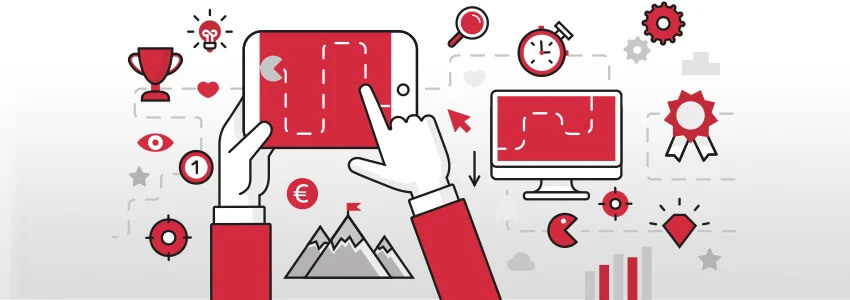Delivering the Right Content at the Right Time
Every successful customer interaction starts with a spark. The spark, in today’s digital world, consists of well-crafted content. Whether it is a blog post or an engaging newsletter, content needs to be present throughout the customer journey to promote customer loyalty and conversions. This article dives deep into how a strategic content approach can nurture leads, address considerations, and ultimately drive conversions and customer loyalty.
Key Points at a Glance
- Content marketing is essential for supporting customer acquisition and retention and offers content for different customer journey phases and searches.
- Strategic content marketing planning requires the identification of buyer personas and an analysis of the customer journey phases in order to place content appropriately at the respective touchpoints.
- Content marketing strategies should be tracked and adapted using KPIs such as page views and conversion rates, which enable continuous optimization of the customer journey.
Content at the Core: Understanding Your Audience
While production, sales, and marketing are the cornerstones of any B2B company, content marketing sits at the heart of engaging customer journeys. It's the key to positioning your business as a trusted advisor and resource, attracting and nurturing leads at every stage.
The digital age has empowered B2B buyers. They actively research and compare solutions online, making it crucial to understand their needs and expectations. This means tailoring your content strategy to each stage of the customer journey.
The Importance and Advantages of Content Marketing in the Customer Journey
Content marketing specializes in creating digital touchpoints and filling them with relevant content that accompanies the customer's journey from the first interaction to purchase and beyond. It is not just about attracting customers, but also about retaining and satisfying them.
Customer loyalty and satisfaction are promoted through the ongoing placement of qualified content after the purchase is completed. The after-sales phase is crucial to meet customer expectations and build a long-term relationship.
The content marketing strategy aims to reach users with relevant topics at the right touchpoint at the right time. This takes into account different types of searches: transaction-oriented, navigation-oriented, and information-oriented.
Content in the customer journey builds trust and sparks a desire for a solution, rather than a direct product push. This is especially true during the awareness and consideration phases. In the conversion phase, helpful product texts and reviews can be offered to support the purchase decision.
How businesses can benefit from strategic content marketing throughout the customer journey:
Content marketing plays a crucial role in shaping the customer journey, as it not only supports the sale of products or services but also offers a variety of benefits for brand building and customer interaction. By strategically placing content at every stage of the customer journey, companies can effectively increase both brand awareness and customer loyalty. Here are the key advantages summarized:
- Improved Brand Awareness and Visibility: Strategically placed content on various platforms increases your brand's visibility and raises awareness among the target audience.
- Increased Dwell Time and Improved Search Engine Ranking: Using videos and interactive content on websites and social media can significantly increase the time users spend on your website, which in turn positively influences SEO ranking.
- Increased Conversion Rate: By providing content that is precisely tailored to the needs of users, especially in critical phases of the purchasing decision, content marketing can improve conversion rates.

Content Marketing Challenges: Keeping Your Audience Engaged Across the Customer's Journey
While content marketing offers numerous advantages, marketers face significant challenges that can hinder the success of their strategies. These challenges require special attention and strategic planning to be effectively addressed:
- Resource Scarcity: Many teams do not have enough time or budget to create content that is strong enough to stand out in a saturated market. This can lead to compromises in the quality and quantity of content produced.
- Complexity of the Customer Journey: The customer journey is often complex and involves many unclear or overlapping data and touchpoints. This makes it difficult for marketers to effectively map the journey and understand which content is most effective when and where.
- The Need for a User-Centric Strategy: Developing a truly user-centric content strategy that is based on a precise target audience definition is challenging. Marketers need to understand exactly who their customers are, what their needs are, and how they can best be addressed.
- SEO and Keyword Research: The foundation of data-driven content marketing is thorough SEO keyword research. Constantly adapting to search engine algorithms and understanding which keywords have the greatest impact is both crucial and challenging.
- Integrating Customer Feedback: Integrating customer feedback into the content creation process is essential to continuously improve content. However, this requires systematic collection and analysis processes to effectively utilize the feedback.
- Standing Out from the Competition: In the face of the so-called content shock, where users are confronted with an overabundance of content on a daily basis, it is a major challenge to stand out from the competition with clearly profiled content.

Strategic Planning for Customer Journey Content Marketing
Strategic planning is key to crafting content that resonates with your audience throughout their customer journey. This involves using the right tools and content at specific touchpoints.
Imagine a customer journey map as a roadmap, guiding potential customers through your sales funnel. Each touchpoint offers tailored content addressing user needs at different stages. Customer journey maps help you identify the best content formats (e.g., blog posts, case studies) and communication channels (e.g., SEO, social media) for each stage.
By focusing on the five key phases (awareness, consideration, intent, purchase, loyalty), your B2B content strategy ensures discoverability and fuels lead generation. Remember, your website remains the central hub, showcasing your brand and driving users to high-quality content across all channels.
Monitoring the performance of your content marketing
While measuring content performance with metrics like pageviews and conversion rates is important, successful customer journey content marketing goes beyond basic analytics. The true challenge lies in understanding the complex customer journey itself. Unclear data and overlapping touchpoints make it difficult to pinpoint exactly which content resonates and influences conversions at each stage.
This is where continuous adaptation and iteration come in. By mapping the customer journey and developing a diverse content library (blog posts for awareness, case studies for consideration), you can create a guiding light for your audience.
Data insights, like identifying buyer personas, can then help identify content gaps and refine your approach to ensure customers find the right content at the right time. Remember, content marketing serves customers throughout their journey, not just until purchase. By focusing on providing valuable and relevant content across all touchpoints, you'll attract, retain, and ultimately convert customers.
Identifying Buyer Personas
Strategic planning for the customer journey hinges on understanding your audience. This is where buyer personas come in - fictional representations of your ideal customers, capturing their demographics, goals, and challenges.
By segmenting your audience into these personas, you can tailor your content to their specific needs and pain points. You can craft blog posts that directly address a persona's struggle during the awareness stage, or creating case studies showcasing success stories relevant to their industry in the consideration stage.
This targeted approach, fueled by buyer personas, ensures your content resonates deeply with each audience segment, ultimately driving conversions and building customer loyalty.
Mapping Content to The Customer Journey
- Awareness Phase
The awareness phase is about generating attention and increasing interest in your brand. Content should be informative and engaging to inform potential customers about solutions that your brand can offer.
- Blog posts: Articles that address general problems or interests in your industry and offer useful information.
- Infographics: Visually appealing content that presents complex data or information in a simple and understandable way.
- Social media posts: Engaging posts that reach a wide audience to increase brand visibility.
- Educational videos: Short clips that explain basic concepts or introduce your brand.
- Consideration Phase
In this phase, potential customers evaluate their options. Content should help them compare the pros and cons and understand why your product or service could be a viable solution to their problems.
- Webinars: In-depth sessions that explore specific topics and demonstrate your expertise.
- Case studies: Detailed analyzes of previous projects or customer stories that show the success of your products or services.
- E-books: Comprehensive guides that guide potential customers through relevant topics and highlight your solutions.
- Comparison guides: Documents that compare your product directly with competitor products.
- Intent Phase
Customers now show a concrete purchase intention. Content should be convincing and make it clear why your solution is the best choice.
- Product demos: Videos or interactive demos that show how your product works and what benefits it offers.
- Testimonials: Statements from satisfied customers that confirm the effectiveness of your products or services.
- Detailed product descriptions: Comprehensive information about the features, benefits and applications of your products.
- Purchase Phase
During the purchase phase, content should support and simplify the purchasing process. This can be achieved by providing:
- FAQ pages: Answers to frequently asked questions that may arise during the purchasing process. This can help to alleviate any concerns or hesitations that potential customers may have, and can also help to reduce the number of support tickets that your team needs to handle.
- Purchase guides: Step-by-step guides that walk customers through the purchasing process. This can help to ensure that customers have a smooth and positive experience when purchasing your products or services.
- Special offers: Time-limited discounts or offers that encourage customers to purchase immediately. This can be a great way to boost sales and generate excitement around your products or services.
- Loyalty Phase
After the purchase, it is important to maintain the relationship with the customer and strengthen customer loyalty. This can be achieved by providing:
- Customer service content: Supportive content that helps customers after the purchase, such as usage tips or maintenance instructions. This can help to ensure that customers are satisfied with your products or services, and can also help to reduce the number of returns or exchanges.
- Loyalty programs: Information about customer loyalty programs that provide incentives for further purchases. This can be a great way to encourage repeat business and build long-term relationships with your customers.
- Newsletters: Regular updates that inform customers about new products, services, or company news. This can help to keep customers engaged with your brand and can also help to generate interest in new offerings.
By providing the right content at each stage of the customer journey, you can effectively guide potential customers from awareness to purchase and beyond. This can help you to increase sales, improve customer satisfaction, and build a loyal customer base.
To-Do List for Your Customer Journey Content Marketing Strategy
- Develop a Content Strategy and include:
- Regularly published, basic content that informs your audience. (Think blog posts, FAQs)
- In-depth content pieces that establish your brand as an authority on a topic. (Think ebooks, whitepapers)
- High-value content pieces that showcase your expertise and attract a wider audience. (Think webinars, infographics)
- Define Your Target Audience:
- Identify your ideal customer profiles and understand their needs and pain points. (Buyer personas)
- Create a Customer Journey Map:
- Visualize the steps your customers take as they interact with your brand.
- Evaluate Communication Channels:
- Choose the best channels to reach your target audience. (Social media, blog, email marketing.)
- Create High-Quality Content
- Use the topic cluster model to organize your content around relevant themes.
- Set Up Feedback Mechanisms:
- Encourage audience interaction and gather insights to improve your content.
- Implement Marketing Automation:
- Streamline your marketing efforts and personalize communication with your audience.
- Track and Analyze Your Results:
- Use analytics tools to measure the success of your content marketing efforts.
We Can Help!
W-4 marketing agency specializes in optimizing B2B customer journeys and lead generation. We analyze each stage of the customer journey to identify areas for improvement and develop targeted solutions. Our expertise helps you understand your customers better and meet their needs. Through targeted content, personalized marketing, and innovative approaches, we can strengthen your B2B relationships and increase your lead generation success. Let's work together to improve your customer journey and drive your business forward. Contact us for more information.









